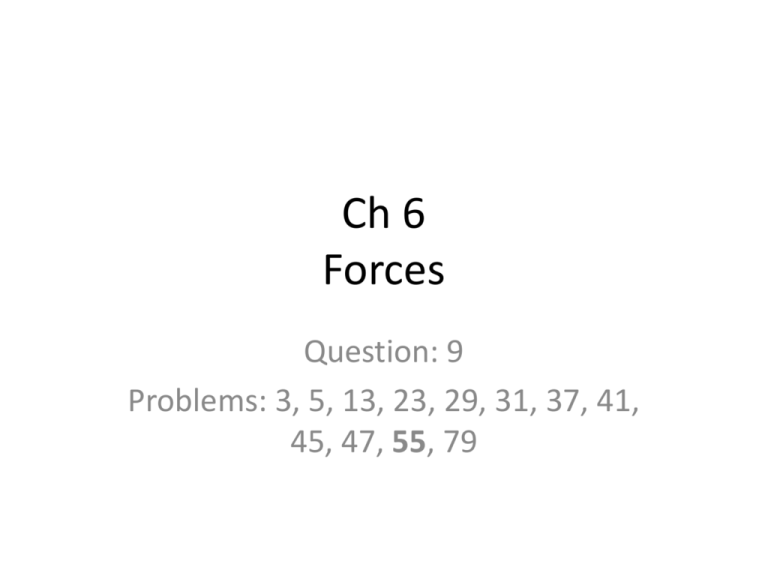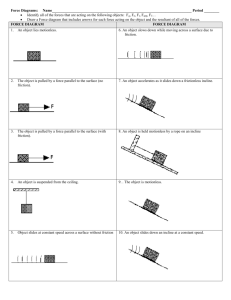Ch 6 Forces
advertisement

Ch 6 Forces Question: 9 Problems: 3, 5, 13, 23, 29, 31, 37, 41, 45, 47, 55, 79 Friction When is friction present in ordinary life? - car brakes - driving around a turn - walking - rubbing your hands together to make warmth - belay/rappel device in rock climbing - moving parts in an engine - sled pulled across ground Friction • Friction is due to surfaces not being perfectly smooth. • Friction force ALWAYS opposes the direction of motion. • The result of friction forces is energy (heat) • Two types of friction: – Static friction force keeps the object at rest, and is needed to be overcome so the object can begin motion. – Kinetic friction occurs when one object is sliding against another surface. Even if two surfaces look smooth, they may not be when viewed on the atomic level. Points in contact stick and hold the surfaces together. Only some of the points on the surfaces come into contact. These points produce static fiction. If the static friction is overcome, the high points tear and a continuous re-forming and breaking of contact points is produced when the objects slide. 1) Push horizontally on a heavy box. The box does not move. Acceleration is zero. The net force is zero. The frictional force is counteracting your force. 2) Push harder. The box still does not move. The frictional force must have increased. 3) Eventually you push hard enough the box begins to slide. At that point you pushed with a force just greater than the maximum friction force. The friction force has an upper limit. This upper limit is determined by two values. The coefficient of static friction. The normal force between surfaces. Ffs, max Magnitude of friction force sliding stationary Breakaway (sliding occurs) How to calculate frictional force. Frictional force, Ff , depends on the material of the two surfaces involves. Given by coefficient of friction ( ). There are two coefficients: static ( s) and kinetic ( k) Ff also depends on the normal force Static friction force Ff sF N Kinetic friction force Ff = kFN no sliding sliding Static friction • Ff sF N • The static friction force can vary from 0 to sFN. • sFN is known as the maximum static friction force. • This is the force needed to be overcome to start sliding an object across the surface. When working problems involving friction, you need to determine the direction of the friction force. M1 M2 Depending on the masses of M1 and M2 and the angle q, the friction force may be pointing up or down the incline. Determine which direction M1 would go if there was no friction. Friction will be in the other direction. Example What coefficient of friction is needed to keep a block from sliding down an incline? The static friction force balances out the parallel component of The weight. FN FP w FN Fs balances out FP From earlier we know FP = mg sin When the box is about to slide down: FN Ff = sFN = smg cos Therefore: smg cos = mg sin Solve for s gives: s = tan Fs FP w FN This tells us the static coefficient, s, needed to keep an object from sliding down an incline depends only on the incline. In this example you are holding a book still, up against the wall. How hard do you have to push to keep the book from sliding? Free body diagram for the book. Ff FPush FN W If the book is not accelerating, the sum of the forces is zero. FN and Fpush counteract each other in the Ff horizontal direction. FPush FN W Weight and friction force balance each other out in the vertical direction. The friction is what is holding up the book. Let the book have mass 5 kg and s = .4. W = (5kg)g = 49 N For W = Ff, Ff = sFN = 0.4FN = 0.4 Fpush 49 N = 0.4 Fpush Fpush= 122.5 N Kinetic Friction Problem You are pushing a block up an incline. The angle of inclination is 30 degrees. The mass of the block is 20 kg. The coefficients of friction are s = 0.3 and k = 0.2. What force must be applied to the box to keep the speed constant? FN Free body diagram Fapplied Ff W Since block is sliding across surface use k = 0.2. Since velocity is constant, a = 0. Fnet = ma = 0 Free body diagram FN + Fapplied We are only concerned with motion along the incline. Ff Incline W Fapplied, Ff, and W have components along the incline. Writing 2nd Law along incline we get: Fapplied - Ff - mg sin 30 = ma = 0 Fapplied = Ff + mg sin 30 = kmg(cos 30)+mg(sin 30) Fapplied = 0.2(20kg)g(cos 30) + (20kg)g(sin 30) = 131 N Pulling with force (F) on box at an angle 2nd Law equations give us: X-direction: F cos = m ax Free Body Diagram FN W F Y-direction: F sin + FN – W = m ay = 0 FN = W – F sin Normal force is reduced So the friction force is less than if the rope is horizontal. Drag force and terminal speed A fluid is anything that can flow, gases or liquids. When there is a relative velocity between an object and the surround fluid, there will be a drag force. examples: air resistance, water resistance Will deal with cases where the object is blunt, the fluid is air, and the motion is fast enough so that the air becomes turbulent behind the object. Drag force depends on the following values: drag coefficient C density of air cross-sectional area A velocity v D = ½ C Av2 The drag force will always be in the direction opposite of the motion. D = ½ C Av2 The drag force depends on the velocity. At slow speeds, it is small, at high speeds becomes very large. As the velocity of an object increases, so does the drag force. Eventually the drag force can equal the accelerating force. When they balance out, the velocity becomes constant. This is defined as the terminal velocity. D D D D Fg Fg Fg Fg Fg When ½ C Av2 – Fg = 0, v will be the terminal velocity, vt. vt 2 Fg C A Some terminal speeds in air Object Terminal speed (m/s) 95% Distance (m) Shot put 145 2500 Sky diver 60 430 baseball 42 210 Tennis ball 31 115 Basketball 20 47 Ping-pong ball 9 10 Raindrop (r=1.5mm) 7 6 parachutist 5 3 95% distance is the distance needed to fall to reach 95% of the terminal velocity. Uniform circular motion a v2 R centripetal acceleration Centripetal force – force that produces the circular motion. examples: dive car around turn, the centripetal force is the friction between wheels and road orbiting satellite, the centripetal force is the gravitational pull of the Earth swing a ball in a circle, the centripetal force is the tensioon in the rope Applying Newton’s 2nd Law to circular motion, 2 v we get: F m R This force is directed towards the center of the circle. When working with Newton’s 2nd law and circular motion, replace the acceleration in F = ma with that of the centripetal acceleration. Obtain the sign by looking at what direction the centripetal force(acceleration) points. Swing a ball, of mass = 1 kg, on a 0.5 meter long string in a vertical circle with a constant speed of 2 m/s. Find the tension in the string when the ball is at the top and bottom of the circle. Look at free body diagrams 2m T a=v2/R a=v2/R Fg Bottom Fg T Top T a=v2/R When the ball is at the bottom of the circle, Newton’s 2nd law gives us: Fg a=v2/R Fg T T mg T mg v2 m R v2 m R When the ball is at the top of the circle, Newton’s 2nd law gives: T T mg v2 m R v2 m R mg Sample problem 6-8 Rider leans against wall of rotating cylinder. Floor falls away, how fast does cylinder have to turn, to keep rider from falling (what is the velocity of the rider). radius = 2.1 m s =0.4 Ff N a=v2/R Fg For the rider not to fall down, the friction must equal the weight. Ff – mg = may ay = 0 Ff = mg s N = mg N = mg/ s In the horizontal plane, the normal force provides the centripetal acceleration. N = m v2/R mg v NR m s m R gR s (9.8 m s 2 )(2.1m) 0.4 7.2m / s Problems: 8, 20, 30, 44





